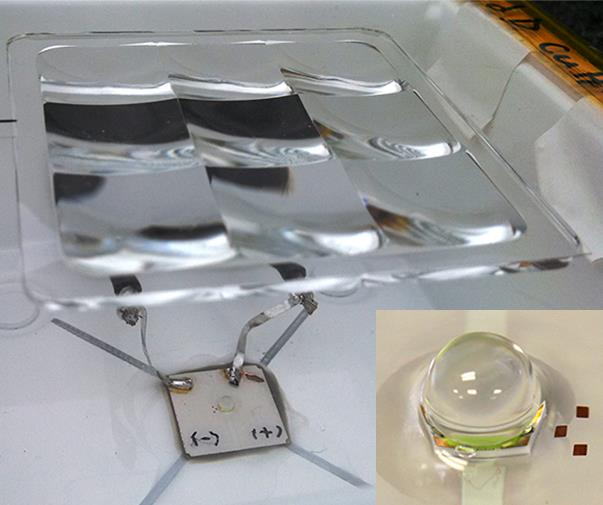
This gives Efficiency of 43.9%,Printing based assembly of quadruple junction,four terminal micro scale solar cells allows realization of extremely high efficiency modules.
The project involved a collaborative team of researchers at the University of Illinois and the photovoltaic companies Semprius and Solar Junction. According to the group’s paper.
For more details >>> Click Here<<<<<<<
The
project involved a collaborative team of researchers at the University
of Illinois and the photovoltaic companies Semprius and Solar Junction.
According to the group’s paper, the module’s top cell consists of a
three-junction (3J) microcell with its own anti-reflective coating to
ensure efficient transmission of light to the uppermost layers. The
bottom cell uses a diffused-junction germanium (Ge) architecture. In a
stacked 3J/Ge assembly, the top 3J cell captures light with wavelengths
between 300 nm and 1,300 nm. Wavelengths from 1,300 nm to 1,700 nm pass
through to the bottom Ge cell with minimal interface reflections, due to
the use of a thin layer of a unique type of chalcogenide glass. - See
more at:
http://engineering.illinois.edu/news/article/7958#sthash.2yr50MuB.dpuf
“Printing-based
assembly of quadruple-junction four-terminal microscale solar cells
allows realization of extremely high-efficiency modules, - See more at:
http://engineering.illinois.edu/news/article/7958#sthash.2yr50MuB.dpuf
“Printing-based
assembly of quadruple-junction four-terminal microscale solar cells
allows realization of extremely high-efficiency modules, - See more at:
http://engineering.illinois.edu/news/article/7958#sthash.2yr50MuB.dpuf
“This
is a high-throughput, parallel assembly process that allows for
simultaneous formation of arrays of stacked multi-junction cells in a
fully automated step-and-repeat mode with high yields—greater than 95
percent—and accurate overlay registration. A newly developed interfacial
material for these stacks enables ideal optical, electrical, and
thermal properties. ” stated Xing Sheng, a postdoctoral fellow with
Rogers’ research group and first author of the paper, “Printing-based
assembly of quadruple-junction four-terminal microscale solar cells
allows realization of extremely high-efficiency modules,” published this
week in the journal Nature Materials. - See more at:
http://engineering.illinois.edu/news/article/7958#sthash.2yr50MuB.dpuf
“This
is a high-throughput, parallel assembly process that allows for
simultaneous formation of arrays of stacked multi-junction cells in a
fully automated step-and-repeat mode with high yields—greater than 95
percent—and accurate overlay registration. A newly developed interfacial
material for these stacks enables ideal optical, electrical, and
thermal properties. ” stated Xing Sheng, a postdoctoral fellow with
Rogers’ research group and first author of the paper, “Printing-based
assembly of quadruple-junction four-terminal microscale solar cells
allows realization of extremely high-efficiency modules,” published this
week in the journal Nature Materials. - See more at:
http://engineering.illinois.edu/news/article/7958#sthash.2yr50MuB.dpuf
“This
is a high-throughput, parallel assembly process that allows for
simultaneous formation of arrays of stacked multi-junction cells in a
fully automated step-and-repeat mode with high yields—greater than 95
percent—and accurate overlay registration. A newly developed interfacial
material for these stacks enables ideal optical, electrical, and
thermal properties. ” stated Xing Sheng, a postdoctoral fellow with
Rogers’ research group and first author of the paper, “Printing-based
assembly of quadruple-junction four-terminal microscale solar cells
allows realization of extremely high-efficiency modules,” published this
week in the journal Nature Materials. - See more at:
http://engineering.illinois.edu/news/article/7958#sthash.2yr50MuB.dpuf
“This
is a high-throughput, parallel assembly process that allows for
simultaneous formation of arrays of stacked multi-junction cells in a
fully automated step-and-repeat mode with high yields—greater than 95
percent—and accurate overlay registration. A newly developed interfacial
material for these stacks enables ideal optical, electrical, and
thermal properties. ” stated Xing Sheng, a postdoctoral fellow with
Rogers’ research group and first author of the paper, “Printing-based
assembly of quadruple-junction four-terminal microscale solar cells
allows realization of extremely high-efficiency modules,” published this
week in the journal Nature Materials. - See more at:
http://engineering.illinois.edu/news/article/7958#sthash.2yr50MuB.dpuf

